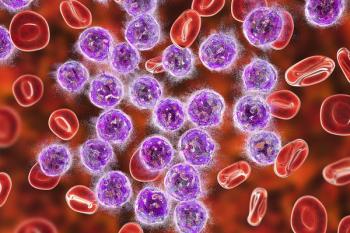
PD-L1 Positivity Predicted Shorter Survival in Non-GCB DLBCL Patients
PD-L1 expression was more common among patients with the GCB subtype of diffuse large B-cell lymphoma, and PD-L1 positivity predicted shorter survival.
Programmed death ligand 1 (PD-L1) expression was more common among patients with the non–germinal-center B-cell–like (GCB) subtype of diffuse large B-cell lymphoma (DLBCL), and PD-L1 positivity predicted shorter survival in these patients, according to the results of a retrospective study
“Immunotherapy targeting the PD-1/PD-L1 pathway may benefit patients with DLBCL, particularly those with non–GCB subtype DLBCL, which might benefit from blockade of the PD-1/PD-L1 immune checkpoint,” wrote Li-Yang Hu, of State Key Laboratory of Oncology in South China, and colleagues.
Researchers reviewed the medical records of 204 patients newly diagnosed with DLBCL from a single center in China between October 2005 and August 2012. Using immunohistochemistry, the researchers evaluated PD-L1 expression in tumor tissue samples. The threshold for positivity was at least 5% of lymphoma cells with PD-L1 expression in tumor cells and at least 20% of malignant and non-malignant cells with PD-L1 expression in the tumor microenvironment.
About half (49.0%) of patients had tumor cells positive for PD-L1, and 21.6% were PD-L1 positive in the tumor microenvironment. PD-L1 positivity was significantly more common in tumor cells (P = .02) and the tumor microenvironment (P = .04) for patients with non–GCB subtype compared with GCB subtype.
In addition, patients with PD-L1 expression in the tumor microenvironment were more likely to be resistant to first-line chemotherapy compared with patients without PD-L1 expression (P = .03).
“Immune evasion owing to PD-L1 expression in tumor cells might be associated with the poor clinical outcomes of patients with ABC subtype DLBCL,” the researchers wrote. “Conversely, the lack of PD-L1 expression in GCB subtype DLBCL specimens is a plausible explanation for the favorable prognosis associated with this disease subtype.”
The researchers also tested for ALK, CD5, CD30, and C-Myc in 109 patient specimens. They found no correlations between PD-L1 expression and expression of ALK, CD5, or CD30. The expression level of PD-L1 in the tumor microenvironment had a negative correlation with that of C-Myc, “which indicates a role of C-Myc in the regulation of PD-L1 expression,” according to the researchers.
The 5-year overall survival rate was 59.5% and the 5-year progression-free survival rate was 50% for the 204 patients. The 5-year overall survival rates were 50% and 67.3% in patients with and without PD-L1 expression in tumor cells (P = .02). PD-L1 expression was an independent risk predictor for overall survival (P < .01). The 5-year progression-free survival rates were 39.6% and 59.6% in patients with and without PD-L1 expression in the tumor microenvironment.
Newsletter
Stay up to date on recent advances in the multidisciplinary approach to cancer.
































































































